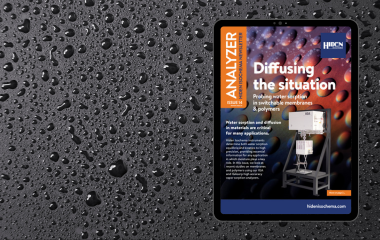Why Use DVS Analysis for Dynamic Packaging Materials Evaluation?
In the realm of packaging science, ensuring the longevity, stability, and integrity of packaging materials is paramount. Dynamic Vapor Sorption (DVS) analysis emerges as a pivotal gravimetric technique in this domain, offering profound insights into the hygroscopic properties of packaging materials.
This blog post delves into the essence of DVS analysis. It considers its significance, methodology, and the multifaceted benefits it brings to the evaluation of packaging materials.
Understanding How DVS Analysis Works
DVS is an analytical technique that measures how a material’s weight changes as it adsorbs or desorbs a solvent vapor, typically water vapor or even organic vapor, under controlled temperature conditions. By exposing a sample to these conditions, critical data can be provided about moisture sorption, hysteresis, desorption isotherms, and kinetics. These are essential for comprehending how packaging materials interact with moisture in their environment.
The Significance of DVS Analysis in Packaging Materials Evaluation
- Moisture Sensitivity Profiling: DVS analysis offers a detailed understanding of the moisture sensitivity of packaging materials. This is crucial for products sensitive to moisture. Examples of these products include pharmaceuticals, electronics, and certain food products, where moisture can compromise quality, efficacy, or shelf life.
- Material Stability and Longevity: By understanding how materials react to humidity changes, manufacturers can predict and enhance the stability and longevity of packaging. This is particularly important for products stored and transported through varying climatic conditions.
- Optimization of Packaging Materials: DVS data aids in selecting the right packaging materials that offer optimal moisture protection for encased products. It facilitates the engineering of materials with specific moisture barriers or absorptive properties, tailored to product requirements.
- Quality Control and Compliance: DVS analysis is instrumental in quality control processes, ensuring that packaging materials meet the necessary standards and regulations. It provides empirical data that can support regulatory submissions and compliance documentation.
- Innovation and Sustainability: Understanding the moisture interaction of materials can drive innovation in packaging design. It can also promote the use of sustainable and biodegradable materials without compromising their protective quality. DVS analysis helps in evaluating the feasibility of new, eco-friendly materials under the environmental conditions they will encounter during their lifecycle.
Methodology of DVS Analysis
DVS analysis involves placing a sample of the packaging material in a controlled environment, such as a temperature controlled chamber, where the humidity is systematically varied. The sample mass is continuously measured as it absorbs and desorbs moisture.
Data obtained from these experiments are used to construct moisture sorption isotherms. These graphically represent the material’s moisture uptake and release behavior.
The precision of DVS instruments allows for the detection of minute changes in weight. This makes it possible to analyze subtle interactions between the packaging material and moisture. Its sensitivity is critical for accurately assessing the performance of advanced, high-barrier materials.
Case Studies and Applications
Several studies highlight the effectiveness of DVS analysis in packaging material evaluation.
For instance, a study on biodegradable packaging materials demonstrated how DVS analysis could identify materials with optimal moisture barrier properties. These are essential for extending the shelf life of food products.
Another study focused on pharmaceutical packaging. Here DVS was used to ensure that the selected materials did not contribute to product degradation through moisture transmission.
Challenges and Considerations
DVS analysis is a powerful tool but it requires expert interpretation of the data to make informed decisions about packaging materials. Various factors can influence the results, including:
- Temperature fluctuations
- The presence of other volatile substances
- Material heterogeneity.
They must be carefully controlled or accounted for during analysis.
DVS analyses allow samples of different sizes to be studied, and the results for equilibrium sorption isotherms may be expected to be invariant with sample size. Diffusion rates, for example, vary as a function of film thickness, and hence the required equilibration time may vary with sample size. Care should be taken to ensure that isotherm measurements are allowed to sufficiently equilibrate. That way the measured amount of vapor that is absorbed by a sample will remain accurate. Therefore, the data and results can stay reliable.
DVS Analysis Is Here to Enhance the Quality of Your Materials As Packaging Solutions
DVS analysis represents a cornerstone in the evaluation of packaging materials. It provides invaluable insights into moisture interactions that can affect product quality, stability, and longevity. Its application spans from ensuring regulatory compliance to fostering innovation in sustainable packaging solutions.
As packaging technology advances, the role of DVS analysis in material selection, optimization, and quality assurance will undoubtedly expand. This will further cement importance in the science of packaging materials.
Not only can DVS analysis be used to learn about amorphous to crystalline conversions, as well as glass transitions, but it can play a vital role in helping us to understand more about what materials are best for packaging. The strategic importance of DVS analysis in advancing packaging material science and ensuring the utmost quality and sustainability of packaging cannot be overstated.
By leveraging DVS analysis, manufacturers can make informed decisions that enhance the protective quality of packaging. They can also meet the demands for sustainability and environmental responsibility. As such, DVS analysis is clearly not just a technique. Instead, think of it as a strategic tool in the development of effective, reliable, and forward-thinking packaging solutions.
At Hiden Isochema, we are at the forefront of providing cutting-edge solutions that empower industries to navigate the complexities of moisture analysis with precision and confidence. Our IGAsorp series is specifically designed to meet the rigorous demands of DVS analysis. It combines unparalleled accuracy with the ease of use to deliver actionable insights.
We invite you to explore how the IGAsorp can transform your approach to packaging material evaluation. That way you can use it to set new standards in product stability and longevity.
Discover more about our innovative solutions and take the next step towards excellence in packaging science by visiting Hiden Isochema’s website and seeing our IGA Dynamic Vapor Sorption Analyzer to see what it can offer you.
Join us in shaping the future of packaging materials through superior analytical techniques.


